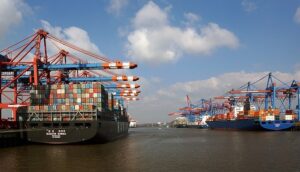• Shippers will in the near term face high rates, space and container shortage, congestion or delays in some ports, cancelled routes leading to cargoes stuck in transshipment ports
• Philippine Multimodal Transport and Logistics Association, Inc. president Marilyn Alberto advises shippers to assess options such as near-shoring and managing risks through multi-sourcing
• Shippers should improve their forecasting of volumes and shipment patterns so they can negotiate ahead with shipping lines for vessel space
 Shippers should anticipate and plan for continued volatility of shipping rates over the near term and for shipping delays and service disruptions, according to an industry executive.
Shippers should anticipate and plan for continued volatility of shipping rates over the near term and for shipping delays and service disruptions, according to an industry executive.
Philippine Multimodal Transport and Logistics Association, Inc. president Marilyn Alberto in an presentation projected that rate levels will remain volatile on all major trade routes.
Rate levels will continue to go up, especially on the trans-Pacific and Europe routes, but contract and spot rates are seen to come down but not to pre-COVID-19 levels, Alberto said at a webinar hosted by Supply Chain Management Association of the Philippines.
Aside from soaring and volatile rates, shippers should also brace for delays and disruption of service, and space and equipment shortage. These are the effects of shipping lines implementing capacity measures such as suspension of services, blank sailings, and re-routing of vessels in response to the pandemic.
Alberto noted they themselves are still experiencing space and equipment shortage, especially on trans-Pacific routes.
Nestle Philippines, Inc. head of inter-market materials management Dennis Llovido, in a presentation during the same webinar, said they have also been encountering issues with container availability, particularly for the in-demand 40-foot high cube (hc) containers.
Other challenges shippers are encountering during this period include congestion or delays in several ports particularly in Asia; vessel schedule reliability issues; cancelled routes leading to cargoes stuck in transshipment ports; and high rates.
On volumes, Alberto said she foresees that in 2021, trade will remain brisk through the Chinese New Year, but demand from recession-hit consumers will be uncertain.
To cope with all these challenges, shippers should find ways to work within the capacity adjustments implemented by shipping networks and improve their forecasting on volume and shipment patterns, she said.
Alberto added that “one thing is sure, according to the carriers, is that capacity strategies, which means limiting available space, is here to stay and shippers will need to find ways to work within the adjusted networks.”
Alberto advised shippers to carefully assess the varied options for adjusting their changing supply chain designs, such as shortening the supply chain by near-shoring and managing risks through multi-sourcing.
They should also improve their forecasting of volumes and shipment patterns so they can negotiate ahead with shipping lines on vessel space needed.
Shippers should likewise aim for closer relationships with their service providers so they can help each other in finding space at the best price possible for their shipments.
Service providers, meanwhile, should improve visibility and agility of door-to-door transport operations, and invest in digitalization and automation.
On container availability, Llovido suggested that shippers look into other types of containers aside from 40-foot hc boxes, and reuse the containers used for their imports and exports. – Roumina Pablo





